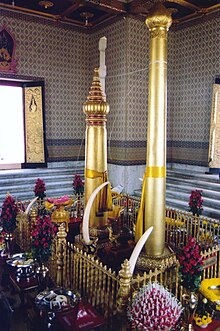
Back Lak Müang German ラックムアン Japanese မြို့စောင့်နတ်တံခွန်တိုင် Burmese Lak Mueang Polish ศาลหลักเมือง Thai 國柱 Chinese

Lak mueang (Thai: หลักเมือง, pronounced [làk mɯ̄a̯ŋ]) are city pillars found in most cities of Thailand. Usually housed in a shrine (ศาลหลักเมือง, [sǎːn làk mɯ̄a̯ŋ]) which is also believed to house Chao Pho Lak Mueang (เจ้าพ่อหลักเมือง, [t͡ɕâw pʰɔ̂ː làk mɯ̄a̯ŋ]), the city spirit deity. It was constructed because the continuation of ancient traditions and Brahman's customs believed that it has something to do with the Held, the single city pillar ceremony (Held “Lak Muang”) which is made of an Acacia wood Chaiyaphreuk (Thai: ชัยพฤกษ์) before the construction of the city for a major goal to build a city and to be the centre of soul for the citizens.
It was probably King Rama I who erected the first city pillar on 21 April 1782, when he moved his capital from Thonburi to Bangkok. The shrine was the first building in his new capital, the palace and other buildings being constructed later.